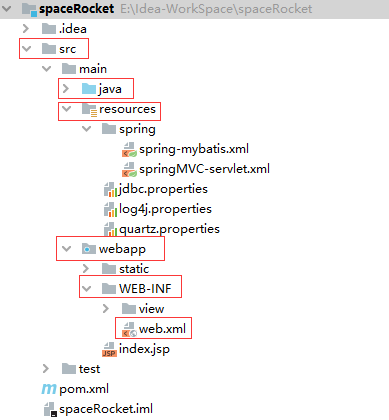标签:glib 实现 顺序 space arch bar 基础 ase display

目录说明:
src/main/java:后台代码
resources: 配置文件
webapp:
static:静态资源文件
WEB-INF:
view: 存放jsp文件
web.xml: 配置Servlet以及Filter
index.jsp: 默认主页
注1:web.xml文件是web项目中总的配置文件,在web.xml中会说明springMVC的配置文件位置和spring配置文件的位置
<?xml version="1.0" encoding="UTF-8"?>
<web-app xmlns="http://xmlns.jcp.org/xml/ns/javaee"
xmlns:xsi="http://www.w3.org/2001/XMLSchema-instance"
xsi:schemaLocation="http://xmlns.jcp.org/xml/ns/javaee http://xmlns.jcp.org/xml/ns/javaee/web-app_3_1.xsd"
version="3.1">
<!--定义站台名称-->
<display-name>Archetype Created Web Application</display-name>
<!--welcome pages-->
<welcome-file-list>
<welcome-file>index.jsp</welcome-file>
</welcome-file-list>
<!---->
<!-- Spring MVC配置 -->
<!-- ====================================== -->
<!--配置springmvc DispatcherServlet-->
<servlet>
<servlet-name>springMVC</servlet-name>
<servlet-class>org.springframework.web.servlet.DispatcherServlet</servlet-class>
<init-param>
<!--配置springMVC-servlet.xml作为mvc的配置文件(自定义servlet.xml配置文件的位置和名称)-->
<param-name>contextConfigLocation</param-name>
<param-value>classpath:spring/springMVC-servlet.xml</param-value>
</init-param>
<load-on-startup>1</load-on-startup>
<async-supported>true</async-supported>
</servlet>
<servlet-mapping>
<servlet-name>springMVC</servlet-name>
<url-pattern>/</url-pattern>
</servlet-mapping>
<!-- Spring配置 -->
<!-- ====================================== -->
<!--把spring-mybatis.xml加入到配置文件中(指定Spring Bean的配置文件所在目录)-->
<context-param>
<param-name>contextConfigLocation</param-name>
<param-value>classpath:spring/spring-mybatis.xml</param-value>
</context-param>
<listener>
<listener-class>org.springframework.web.context.ContextLoaderListener</listener-class>
</listener>
</web-app>
注2:SpringMVC是一个基于DispatcherServlet的MVC框架,每一个请求最先访问的都是DispatcherServlet,DispatcherServlet负责转发每一个Request请求给相应的Handler,Handler处理以后再返回相应的视图(View)和模型(Model),返回的视图和模型都可以不指定,即可以只返回Model或只返回View或都不返回。
DispatcherServlet是继承自HttpServlet的,既然SpringMVC是基于DispatcherServlet的,那么我们先来配置一下DispatcherServlet,好让它能够管理我们希望它管理的内容。HttpServlet是在web.xml文件中声明的。
servlet:
servlet-class:配置DispatcherServlet,
init-param:
param-value:这是springMVC配置文件的位置
load-on-startup:表示servlet被加载的先后顺序,值越小,优先级越高。若是负整数或者没设置,那就是容器会当Servlet被请求时再加载;若是正整数或0,容器在应用启动时就加载并初始化这个servlet。
async-supported:servlet 3.0后推出的新特性,作用是支持异步处理
context-param:
param-name: contextConfigLocation(表示这是spring的配置文件)
param-value: spring配置文件的位置
listenner: 监听器
1、启动一个WEB项目的时候,WEB容器会去读取它的配置文件web.xml,读取<listener>和<context-param>两个结点。
2、紧急着,容创建一个ServletContext(servlet上下文),这个web项目的所有部分都将共享这个上下文。
3、容器将<context-param>转换为键值对,并交给servletContext。
4、容器创建<listener>中的类实例,创建监听器。
(2)Load-on-startup指定servlet被加载的顺序
(3)加载顺序:ServletContext-> context-param -> listener -> filter -> servlet
1、web应用图标:指出IDE和GUI工具用来表示Web应用的大图标和小图标
<icon>
<small-icon>/images/rocket.png</small-icon>
<large-icon>/images/space.png</large-icon>
</icon>
2、web应用名称:提供GUI工具可能会用来标记这个特定的web应用的一个名称
<display-name>spaceRocket</display-name>
3、web应用描述:给出与此相关的说明性文本
<disciption>spaceRocket servlets and JSP pages.</disciption>
4、上下文参数:声明应用范围内的初始化参数
<context-param> <param-name>ContextParameter</para-name>
<param-value>test</param-value>
<description>It is a test parameter.</description>
</context-param>
在servlet里面可以通过getServletContext().getInitParameter("context/param")得到
5、过滤器配置:将一个名字与一个实现javaxs.servlet.Filter的类相关联
<filter>
<filter-name>setCharacterEncoding</filter-name>
<filter-class>com.blueice.setCharacterEncodingFilter</filter-class>
<init-param>
<param-name>encoding</param-name>
<param-value>GB2312</param-value>
</init-param>
</filter>
<filter-mapping>
<filter-name>setCharacterEncoding</filter-name>
<url-pattern>/*</url-pattern>
</filter-mapping>
6、监听器配置
<listener>
<listerner-class>listener.SessionListener</listener-class>
</listener>
7、servlet配置
基本配置
<servlet>
<servlet-name>snoop</servlet-name>
<servlet-class>SnoopServlet</servlet-class>
</servlet>
<servlet-mapping>
<servlet-name>snoop</servlet-name>
<url-pattern>/snoop</url-pattern>
</servlet-mapping>
高级配置
<servlet>
<servlet-name>snoop</servlet-name>
<servlet-class>SnoopServlet</servlet-class>
<init-param>
<param-name>foo</param-name>
<param-value>bar</param-value>
</init-param>
<run-as>
<description>Security role for anonymous access</description>
<role-name>tomcat</role-name>
</run-as>
</servlet>
<servlet-mapping>
<servlet-name>snoop</servlet-name>
<url-pattern>/snoop</url-pattern>
</servlet-mapping>
元素说明
<servlet></servlet> 用来声明一个servlet的数据,主要有以下子元素: <servlet-name></servlet-name> 指定servlet的名称 <servlet-class></servlet-class> 指定servlet的类名称 <jsp-file></jsp-file> 指定web站台中的某个JSP网页的完整路径 <init-param></init-param> 用来定义参数,可有多个init-param。在servlet类中通过getInitParamenter(String name)方法访问初始化参数 <load-on-startup></load-on-startup>指定当Web应用启动时,装载Servlet的次序。 当值为正数或零时:Servlet容器先加载数值小的servlet,再依次加载其他数值大的servlet. 当值为负或未定义:Servlet容器将在Web客户首次访问这个servlet时加载它
<servlet-mapping></servlet-mapping> 用来定义servlet所对应的URL,包含两个子元素 <servlet-name></servlet-name> 指定servlet的名称 <url-pattern></url-pattern> 指定servlet所对应的URL
8、会话超时配置
<session-config>
<session-timeout>120</session-timeout>
</session-config>
9、MIME类型配置
<mime-mapping>
<extension>htm</extension>
<mime-type>text/html</mime-type>
</mime-mapping>
10、指定欢迎页配置
<welcome-file-list>
<welcome-file>index.jsp</welcome-file>
<welcome-file>index.html</welcome-file>
<welcome-file>index.htm</welcome-file>
</welcome-file-list>
11、配置错误页面
通过错误码来配置error-page
<error-page>
<error-code>404</error-code>
<location>/NotFound.jsp</location>
</error-page>
通过异常的类型来配置error-page
<error-page>
<exception-type>java.lang.NullException</exception-type>
<location>/error.jsp</location>
</error-page>
12、TLD配置
<taglib>
<taglib-uri>http://jakarta.apache.org/tomcat/debug-taglib</taglib-uri>
<taglib-location>/WEB-INF/jsp/debug-taglib.tld</taglib-location>
</taglib>
如果MyEclipse一直在报错,应该把<taglib> 放到 <jsp-config>中
<jsp-config>
<taglib>
<taglib-uri>http://jakarta.apache.org/tomcat/debug-taglib</taglib-uri>
<taglib-location>/WEB-INF/pager-taglib.tld</taglib-location>
</taglib>
</jsp-config>
13、资源管理对象配置
<resource-env-ref>
<resource-env-ref-name>jms/StockQueue</resource-env-ref-name>
</resource-env-ref>
14、资源工厂配置
<resource-ref>
<res-ref-name>mail/Session</res-ref-name>
<res-type>javax.mail.Session</res-type>
<res-auth>Container</res-auth>
</resource-ref>
配置数据库连接池就可在此配置
<resource-ref>
<description>JNDI JDBC DataSource of shop</description>
<res-ref-name>jdbc/sample_db</res-ref-name>
<res-type>javax.sql.DataSource</res-type>
<res-auth>Container</res-auth>
</resource-ref>
15、安全限制配置
<security-constraint>
<display-name>Example Security Constraint</display-name>
<web-resource-collection>
<web-resource-name>Protected Area</web-resource-name>
<url-pattern>/jsp/security/protected/*</url-pattern>
<http-method>DELETE</http-method>
<http-method>GET</http-method>
<http-method>POST</http-method>
<http-method>PUT</http-method>
</web-resource-collection>
<auth-constraint>
<role-name>tomcat</role-name>
<role-name>role1</role-name>
</auth-constraint>
</security-constraint>
16、登录验证配置
<login-config>
<auth-method>FORM</auth-method>
<realm-name>Example-Based Authentiation Area</realm-name>
<form-login-config>
<form-login-page>/jsp/security/protected/login.jsp</form-login-page>
<form-error-page>/jsp/security/protected/error.jsp</form-error-page>
</form-login-config>
</login-config>
17、安全角色
security-role元素给出安全角色的一个列表,这些角色将出现在servlet元素内的security-role-ref元素的role-name子元素中。
分别的声明角色可是高级IDE处理安全信息更为容易。
<security-role>
<role-name>tomcat</role-name>
</security-role>
18、web环境参数
env-entry元素声明web应用的环境项
<env-entry>
<env-entry-name>minExemptions</env-entry-name>
<env-entry-value>1</env-entry-value>
<env-entry-type>java.lang.Integer</env-entry-type>
</env-entry>
19、EJB声明
<ejb-ref>
<description>Example EJB reference</decription>
<ejb-ref-name>ejb/Account</ejb-ref-name>
<ejb-ref-type>Entity</ejb-ref-type>
<home>com.mycompany.mypackage.AccountHome</home>
<remote>com.mycompany.mypackage.Account</remote>
</ejb-ref>
20、本地EJB声明
<ejb-local-ref>
<description>Example Loacal EJB reference</decription>
<ejb-ref-name>ejb/ProcessOrder</ejb-ref-name>
<ejb-ref-type>Session</ejb-ref-type>
<local-home>com.mycompany.mypackage.ProcessOrderHome</local-home>
<local>com.mycompany.mypackage.ProcessOrder</local>
</ejb-local-ref>
21、配置DWR
<servlet>
<servlet-name>dwr-invoker</servlet-name>
<servlet-class>uk.ltd.getahead.dwr.DWRServlet</servlet-class>
</servlet>
<servlet-mapping>
<servlet-name>dwr-invoker</servlet-name>
<url-pattern>/dwr/*</url-pattern>
</servlet-mapping>
22、配置Struts
<display-name>Struts Blank Application</display-name>
<servlet>
<servlet-name>action</servlet-name>
<servlet-class>
org.apache.struts.action.ActionServlet
</servlet-class>
<init-param>
<param-name>detail</param-name>
<param-value>2</param-value>
</init-param>
<init-param>
<param-name>debug</param-name>
<param-value>2</param-value>
</init-param>
<init-param>
<param-name>config</param-name>
<param-value>/WEB-INF/struts-config.xml</param-value>
</init-param>
<init-param>
<param-name>application</param-name>
<param-value>ApplicationResources</param-value>
</init-param>
<load-on-startup>2</load-on-startup>
</servlet>
<servlet-mapping>
<servlet-name>action</servlet-name>
<url-pattern>*.do</url-pattern>
</servlet-mapping>
<welcome-file-list>
<welcome-file>index.jsp</welcome-file>
</welcome-file-list>
<!-- Struts Tag Library Descriptors -->
<taglib>
<taglib-uri>struts-bean</taglib-uri>
<taglib-location>/WEB-INF/tld/struts-bean.tld</taglib-location>
</taglib>
<taglib>
<taglib-uri>struts-html</taglib-uri>
<taglib-location>/WEB-INF/tld/struts-html.tld</taglib-location>
</taglib>
<taglib>
<taglib-uri>struts-nested</taglib-uri>
<taglib-location>/WEB-INF/tld/struts-nested.tld</taglib-location>
</taglib>
<taglib>
<taglib-uri>struts-logic</taglib-uri>
<taglib-location>/WEB-INF/tld/struts-logic.tld</taglib-location>
</taglib>
<taglib>
<taglib-uri>struts-tiles</taglib-uri>
<taglib-location>/WEB-INF/tld/struts-tiles.tld</taglib-location>
</taglib>
23、配置Spring(基本上都是在Struts中配置的)
<!-- 指定spring配置文件位置 -->
<context-param>
<param-name>contextConfigLocation</param-name>
<param-value>
<!--加载多个spring配置文件 -->
/WEB-INF/applicationContext.xml, /WEB-INF/action-servlet.xml
</param-value>
</context-param>
<!-- 定义SPRING监听器,加载spring -->
<listener>
<listener-class>org.springframework.web.context.ContextLoaderListener</listener-class>
</listener>
<listener>
<listener-class>
org.springframework.web.context.request.RequestContextListener
</listener-class>
</listener>
参考文档1:https://blog.csdn.net/yangshuaionline/article/details/90476048
参考文档2:https://www.cnblogs.com/superjt/p/3309255.html
参考文档3:https://www.cnblogs.com/shamo89/p/9942291.html
参考文档4:https://developer.ibm.com/zh/articles/j-lo-servlet30/
标签:glib 实现 顺序 space arch bar 基础 ase display
原文地址:https://www.cnblogs.com/steveshao/p/13492333.html